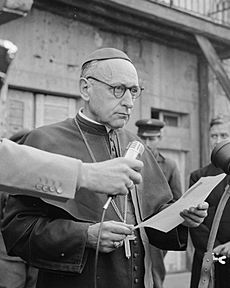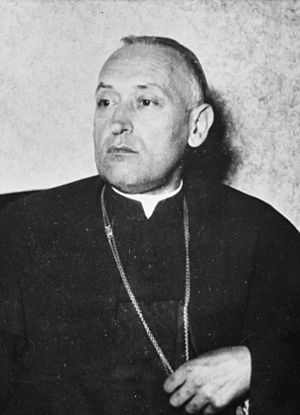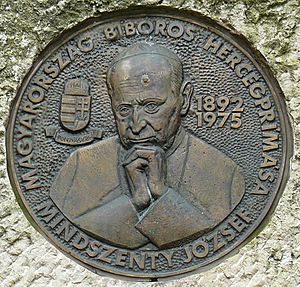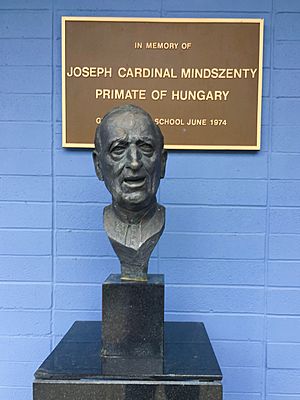József Mindszenty facts for kids
Quick facts for kids His Eminence József Mindszenty Venerable |
|
|---|---|
|
|
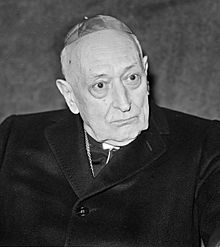
Mindszenty in 1974
|
|
| Archdiocese | Esztergom |
| Appointed | 2 October 1945 |
| Reign ended | 19 December 1973 |
| Predecessor | Jusztinián György Serédi |
| Successor | László Lékai |
| Other posts | Cardinal Priest of Santo Stefano al Monte Celio (1946–1974) |
| Orders | |
| Ordination | 12 June 1915 |
| Consecration | 25 March 1944 by Jusztinián György Serédi |
| Created Cardinal | 18 February 1946 |
| Rank | Cardinal priest |
| Personal details | |
| Birth name | József Pehm |
| Born | March 29, 1892 Csehimindszent, Kingdom of Hungary |
| Died | 6 May 1975 (aged 83) Vienna, Austria |
| Buried | Esztergom Basilica |
| Parents |
|
| Previous post |
|
| Motto | Pannonia Sacra |
| Signature |  |
| Coat of arms |  |
| Sainthood | |
| Venerated in | Roman Catholic Church |
| Title as Saint | Venerable |
| Styles of József Mindszenty |
|
|---|---|
 |
|
| Reference style | His Eminence |
| Spoken style | Your Eminence |
| Informal style | Cardinal |
| See | Esztergom |
József Mindszenty (born József Pehm; 29 March 1892 – 6 May 1975) was a Hungarian cardinal and a brave leader of the Catholic Church in Hungary. He served as the Archbishop of Esztergom from 1945 to 1973. For many years, he was known for strongly opposing both fascism and communism in Hungary.
During World War II, he was put in prison by the pro-Nazi Arrow Cross Party. After the war, he continued to speak out against the new communist government. Because of his strong beliefs, he was arrested, tortured, and given a life sentence in 1949. This trial was unfair and caused people around the world to speak out against it.
After spending eight years in prison, Mindszenty was set free during the Hungarian Revolution of 1956. He found safety at the United States embassy in Budapest, where he lived for the next fifteen years. In 1971, he was finally allowed to leave Hungary. He died in 1975 in Vienna, Austria, far from his home country.
Who Was József Mindszenty?
József Mindszenty was born on March 29, 1892, in a village called Csehimindszent in Hungary. His father was a local judge. He went to school and then studied to become a priest.
He became a priest on June 12, 1915. He wrote books, and his first one, Motherhood, was published in 1917. He was arrested twice in 1919 for speaking out against the socialist and communist governments at the time.
Mindszenty's Fight Against Totalitarian Rule
Mindszenty was a strong voice against unfair governments. In 1939, he told people to vote against the Arrow Cross Party, which was a pro-Nazi group. He even wrote a pamphlet in 1940 calling them evil, just like the communists.
In 1941, he changed his last name to Mindszenty, which came from his home village. This was part of a movement to use Hungarian names. On March 25, 1944, he became the Bishop of Veszprém. He tried to protect Jewish people who had converted to Christianity and protested against the Nazis. He was arrested again in November 1944 for opposing the Arrow Cross government. He was released in April 1945.
Leading the Church and Opposing Communism
After World War II, Mindszenty became the leader of the Catholic Church in Hungary. On September 15, 1945, he was made Primate of Hungary and Archbishop of Esztergom. In 1946, Pope Pius XII made him a Cardinal-Priest. The Pope reportedly told him he would be the first to suffer for his beliefs.
The new communist government saw Mindszenty as a major opponent. He continued to use his traditional title, even though the government had banned noble titles. He also spoke out when the government took away lands owned by the Church. These lands were the main way the Church supported its schools and charities.
Cardinal Mindszenty believed that the Church should only rely on God's protection. He strongly fought against the government taking control of schools run by the Church. In 1948, the government also banned religious groups.
Mindszenty's Arrest and Unfair Trial
On December 26, 1948, Cardinal Mindszenty was arrested. The government accused him of serious crimes against the new Hungarian state. Before his arrest, he wrote a note saying that any confession he made would be because he was forced. While in prison, he was treated badly until he agreed to confess.
His forced confession included admitting to planning to bring back the old royal family and overthrow the government. He also "admitted" to planning a third World War and wanting to become the supreme leader if the Americans won.
On February 3, 1949, Mindszenty's unfair trial began. He admitted to some contacts with foreign leaders but denied wanting war or spying. He said, "we prayed for peace." On February 8, he was sentenced to life in prison. The government released a book with his supposed confessions.
On February 12, 1949, Pope Pius XII announced that everyone involved in Mindszenty's unfair trial was removed from the Church. The Pope also publicly condemned the conviction and described the torture Mindszenty faced.
Freedom and Life in the US Embassy
Over seven years later, on October 30, 1956, during the Hungarian Revolution of 1956, Mindszenty was released from prison. He returned to Budapest and spoke out in support of the people fighting against the communist government.
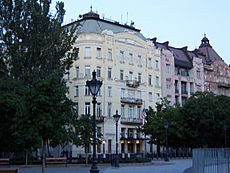
On November 4, 1956, the Soviet Union invaded Hungary to stop the revolution. Cardinal Mindszenty sought safety at the United States embassy in Budapest. He lived there for the next 15 years, unable to leave the embassy grounds. This meant he could not attend important meetings of cardinals in Rome.
Life in Exile and Passing Away
Eventually, Pope Paul VI worked out a deal. Mindszenty was allowed to leave Hungary on September 28, 1971. He moved to Vienna, Austria. He did not want to give up his title as the leader of the Catholic Church in Hungary.
In December 1973, at 81 years old, Mindszenty's titles were removed by the Pope. The Pope declared the position of Archbishop of Esztergom empty, but he did not fill it while Mindszenty was still alive. Mindszenty visited Hungarian people living in other countries in 1975. He died on May 6, 1975, in Vienna, at the age of 83.
Mindszenty's Lasting Impact
In 1991, after communism ended in Hungary, Mindszenty's remains were brought back to Hungary. He was buried in the Esztergom Basilica.
Today, many people in Hungary admire Mindszenty for his bravery. He stood strong against the Nazi-aligned Arrow Cross Party, during his time in communist prison, and while living in exile.
There is a Mindszenty Museum in Esztergom dedicated to his life. Statues and memorials honoring him can be found in places like New Brunswick, New Jersey, Cleveland, and Santiago, Chile. He also visited the Woodside Priory School in California, which was founded by Hungarian monks who fled after the 1956 revolution.
The Path to Sainthood
The process to declare Cardinal Mindszenty a saint has been ongoing since communism fell in 1989. This process is called beatification and then canonization.
The official process began on June 15, 1993. Mindszenty is now called a Servant of God. In 2012, the Hungarian Bishops' Conference showed their support for continuing the process. On February 12, 2019, Pope Francis declared Mindszenty venerable, which is an important step towards becoming a saint.
See also
 In Spanish: József Mindszenty para niños
In Spanish: József Mindszenty para niños
- Josef Beran
- John Fisher
- Ignatius Kung Pin-Mei
- Josyf Slipyj
- Alojzije Stepinac
- Stefan Wyszyński
- List of Eastern Bloc defectors
- List of people granted political asylum
- The Black Book of Communism


